How can I determine the head position and eye alignment necessary for me to have the best aiming accuracy and consistency?
Having your head aligned properly is the most important fundamental of pool. “How to Easily Find Your Vision Center” (BD, June, 2023) and “Aim, Align, Sight – Part II: Visual Alignment” (BD, July, 2011) covers this topic fairly well, as do the following videos, one from Vol. I of the Video Encyclopedia of Pool Practice (VEPP):
Your vision center is the head and eye alignment, relative to the cue, that allows you to see a center-ball, straight-in shot as straight, with the tip appearing to be at the center of the CB. For some people, this might be with the cue under their dominant eye (e.g., if they have strong eye dominance and/or vision impairment in the other eye). For others, it might be with the cue under their nose, or somewhere else between (or even outside of) their eyes. To be accurate and consistent with both straight-in and cut shots, you should always position your “vision center” over the desired aiming line for the shot. See shot sighting for more information (and other approaches).
As illustrated in the following video, in general it is best to have your head as square to the shot as possible, and with the eyes as level as possible, in the “vision center” position. For more information, see Diagram 4 and the pertinent discussion in “Aim, Align, Sight – Part II: Visual Alignment” (BD, July, 2011):
It is best if your vision center is aligned with the shot line the entire time while you are aiming a shot in the standing position and as you drop down into your stance, as demonstrated in the following videos:
Many of the things some people do wrong concerning visual alignment are demonstrated in the following video:
A useful technique to find your “vision center” is to set up a straight-in shot (e.g., with the CB and OB along the diagonal of the table, with the OB close to a corner pocket and the CB close to the middle of the table) with a cue shaft carefully laid down on the table centered in front of the CB and perfectly aligned with the straight line of the shot. Then position your head over the shaft close to the place and orientation your head would be while down in your stance. Then move your head left and right, without tilting or turning, until the tip position looks centered and the shaft and shot alignment look perfectly straight. This head position is your “vision center.” Here’s a good demonstration of this approach:
Here’s a similar technique using mechanical bridges (snooker “rests”) to support the cue:
Other techniques to visually find your vision center position is to use a mirror with a vertical line, as demonstrated in the following video:
Another way to check your vision center is with a line of balls as demonstrated in this video; although, it is generally better to find your vision while in your stance and shooting position:
A good way to test your vision center is to use the MOFUDAT and related drills. This will test if you are aligning with the center of the CB and if you are able to consistently send the CB along a straight line. Another useful drill is the cut shot drill (F6) in Exam I of the Billiard University (BU) playing-ability tests. If you tend to miss shots in one direction more than the other, you might want to recheck your vision center position.
Another good drill to help you find and test your vision center, per the video at the top of the page, is to set up a long straight-in shot into a corner pocket, marking the CB and OB positions with self-adhesive hole reinforcements (AKA, a “little white donuts”). Then hit stop shots. If the CB has no sidespin after hitting the OB, and if the OB goes into the center of the pocket consistently, then you have your vision center properly aligned (and you have a good stroke). If not, then shifting your head might help (assuming your stroke is good). If the CB consistently goes to the right of target, causing the OB to go left of the pocket, your left eye is probably dominating the perception of the line of the cue. This causes you to position the cue a little to the left of center and to pivot the cue a little to the right of the desired line of aim. With your eye alignment to the left of center, you perceive the shifted and pivoted cue position as centered and straight, but it is not. If this is the case, try shifting your head to the right a little, and then try another set of stop shots. If you are consistently missing the CB target to the left instead, with the OB missing the pocket to the right, try shifting your head to the left. After you find the head alignment that results in the best accuracy (i.e., no CB spin, and OB in the center of the pocket), you will have found your vision center. When you are done, try to remember how the stance feels and/or where your nose or chin is relative to the cue (e.g., by lowering your chin to touch the cue and/or by glancing down at the cue with your eyes, keeping your head still).
When playing, you can verify that your vision center is aligned properly by touching your chin to cue if your stance is low enough to do this. There are several advantages to having a low stance. Accurate and consistent visual alignment is one. Otherwise, when down in your stance, just glance down with your eyes (with the head still) to see where the cue is relative to your eyes and nose. Obviously, you want the cue in the same place as it was when you determined your “vision center” with the drills above. Regardless of what you use as your “vision center” position, the most important factor is being as consistent as possible so your brain can learn to judge the full range of shots from the same perspective.
For a person with an extremely dominant eye (or only one eye with vision), the best “vision center” position is usually with the cue directly beneath this eye, making it much easier to align consistently and accurately. Also, a single eye provides only one “picture” for the brain to process, so parallax issues are not a concern. Although, the direct depth perception that comes with binocular vision can be very helpful in pool to better visualize angles (e.g., cut angles) and distances (e.g., how close the tip is to the CB at address).
For more information, see “VEPP – Part I: Introduction and Fundamentals,” (BD, April, 2012).
Here’s useful 2-page visual summary of “vision center” concepts and drills.
In the VEPP vision center video, why does the shooter not follow through straight?
Bob (the shooter) has a slight swoop in his stroke, so he does not follow through perfectly straight. This is something he learned to do over many, many years as a result of his vision-center alignment being slightly off. It causes him to align slightly off center at address and aim slightly off line. By coming through the shot with a slight swoop, he corrects for both. He does not do any of this consciously. It is something he learned to do subconsciously through years and years of reinforcing practice. Obviously, we wouldn’t recommend this approach, and it does not change the important messages of the video. But for Bob to change this now would be extremely difficult. He has played at a very high level for many, many years, and he does all of this naturally. He was actually a collegiate national champion in the past, using these technique “flaws.” Honestly, this bothered me while we were filming this segment, and we discussed it at length, but we thought the messages of the video are still clear and people can still utilize the vision-center-checking approach to help their individual games.
For a shot with sidespin, where should you align your “vision center?”
One approach is to always start with a center-ball alignment so everything (vision center, cue, CB, OB target) is aligned initially. Then you can pivot the cue and vision center together to change the alignment for the sidespin. A good approach for this is the SAWS BHE/FHE Calibration System. After the pivot, the vision center is now aligned only with the cue. For people who come right down into the line of the shot when using sidespin (with no pivot), it is probably best for the vision center to be aligned with the cuing direction the whole time.
Some books, videos, and instructors claim it is better to position your head in a “natural” position with the “dominant eye” over the cue. Is that wrong?
For someone with very strong eye dominance (or impaired vision in the other eye), having the cue directly under the dominant eye is usually the best approach. And it is possible to reach a high level of play with the head in any position, with enough consistent practice and experience. However, this is not the best (most effective) approach for most people. What comes natural is not always the best approach.
In the past I used to position my head with the cue fairly close to my dominant eye. That came naturally to me. However, at some point I realized I was not visualizing lines of aim and cue alignments correctly. At times I would make subconscious corrections, but I would often miss long shots, even when I was aiming and stroking very carefully. Once I realized that I could visualize everything more correctly by instead positioning my head in my personal “vision center” position (with the cue more centered under my chin), I made changes in my stance to allow me to get my head in the right place and to comfortably lower my stance. My game improved immediately as a result. I have also successfully worked with many students who have had similar issues, and they certainly would not agree with your assessment of my approach. Also, there are many top players (pool and snooker) who have a dominant eye and yet position the cue somewhere other than beneath (or close to) their dominant eye. Many (if not most) of these players have the cue centered (or very close to centered) between the eyes, with the cue touching (or almost touching) the center of their chin.
Regardless, as with all fundamentals, one can learn to master anything, even if it isn’t what makes sense as the “best practices” approach. A good example is Bob Jewett (past National Collegiate Champion) who was mentioned above. For his entire pool-playing life, he has positioned his head in the “wrong” place (i.e., not in his personal “vision center” position). As a result of this, he doesn’t quite see the CB center or the line of the shot correctly. To compensate, he subconsciously learned to swoop his stroke slightly. Because he put in so much practice time over so many years, he has managed to master this technique fairly well. However, he agrees with me that he probably would have had a much easier journey (and maybe could have excelled even earlier and at a higher level) if he had started with his head in the right place. Then he would not have needed to subconsciously (or consciously) make aiming or stroking corrections. And he would have been able to use a perfectly straight stroke.
from Neil:
Take an extra shaft and lay it on the table pointing away from you. Get down in your stance with your cue with your bridge hand at the end of the spare shaft. Place your cue over the shaft. When you see equal parts of the shaft on each side of your cue, you then know you are seeing a straight line. That is where your head should be.
from BeiberLvr (in AZB post):
I’m going to give you all a detailed guide on how you can easily find your vision center without being near a pool table.
Material List:
– Strip of Paper – 4-5″ (L) x 1/2″ (W) – it’s best to use a thicker stock of paper … something like a playing card or index card would be ideal.
– Double Sided Tape (regular tape can be substituted)
– Bathroom Mirror
Set Up:
– Make an approximate 1/4″ fold on either end of the paper, so that it looks like a “J” or “L”
– Stick a small piece of tape on the mirror, at around chin level.
– Stick the “hook” of the paper on the tape so the paper is sticking towards you.
– The paper facing you should be vertical.
All that’s left to do is stand directly in line with the paper, and look up slightly at your eyes. Where ever the paper is lined up is your vision center.
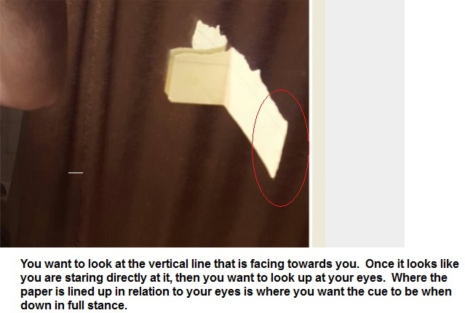
The way the camera (see below) is seeing it is how your eyes should see when your head is in the correct position. Please note how neither the face or back of the card is visible. That’s what you’re aiming for when doing the test.
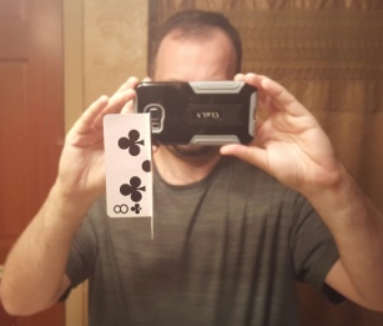
from Pidge (in AZB post), related to method shown in the following Steve Davis snooker-tips video:
What you need is a pool table and some tape. Tape that’s about half an inch or thinner is perfect. Now, what you need to do is stick the tape on the table bed, about 12 inches away from the rail. Bring the tape back towards the rail keeping it as straight as possible and place it under the rail, then up the cushion and along the rail again keeping it nice and straight. The tape should be staggered due to the height increase onto the rail from the baize. This step is the important part in showing you how you see a straight line as straight, and just as importantly where you are lined up on the cue ball is in fact where you are lined up. So, if it looks like you are hitting centre ball you are in fact lined up to strike centre ball. All you have to rely on then is the rest of your fundamentals. So, this line of tape….you will notice as you move around the table and move the head the line stops looking straight. You need to stand in a way that this line looks dead straight. This is how you will need to stand behind the shot at hand when using what ever aiming method you choose. If you need to line centre to centre for a straight in, you stand as though the line is from centre to centre. Centre to edge…exactly the same. Now, place your cue along this line, or a spar shaft. Make sure its perfectly aligned and do what ever it takes to keep it still. I personally tape an old shaft to the rail when showing people this. Now you need to get down as though you’re about to shoot. Does the shaft look straight along the tape with the tip aimed at the end of the tape? If not you need to move your head until it does. When it does, stop, take in the new head over the cue position and this is how your head needs to be over the cue on all shots.
from JoeW:
Photo 1 shows the table with a line drawn from the head to the foot of the table on the center diamond. I used a dressmaker’s marking pencil (cost $1.00 at Walmart) to draw the line. I left the pencil on the table for this photo.
For a ruler I used an 8’ piece of metal wall board corner molding ($2.00 at Home Depot). Note that the line goes from one end of the table to the other.
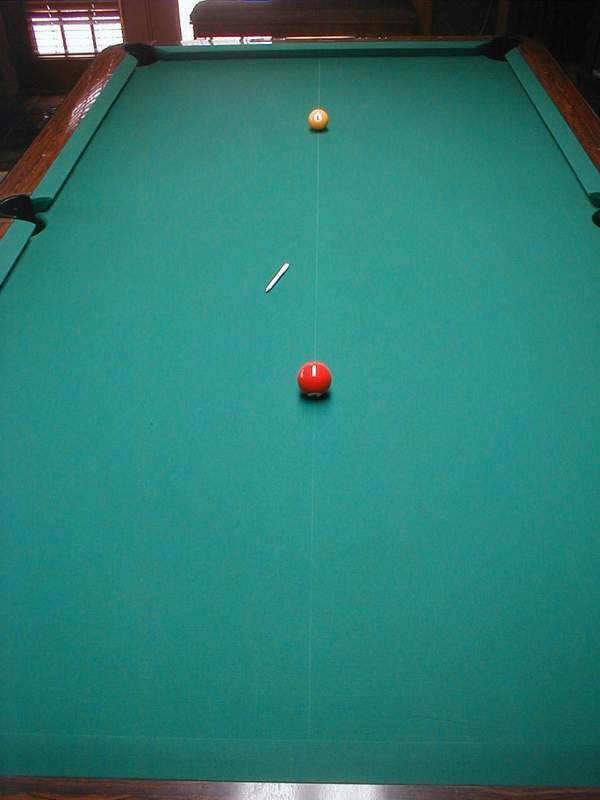
Photo 1
The balls are set with the base of the One ball on the line (see Photo 2) with the center of the numeral One centered on the line. If you look over the top of the One ball you can see the other side of the ball and that the number One lines up with the white line. Go to the other end of the table and set the Three ball in the same way.
The balls are now lined up perfectly. If you hit dead center on the One, stop on the Three ball the three ball should bank off the end of the table and come back and hit the One ball – a really tough shot.
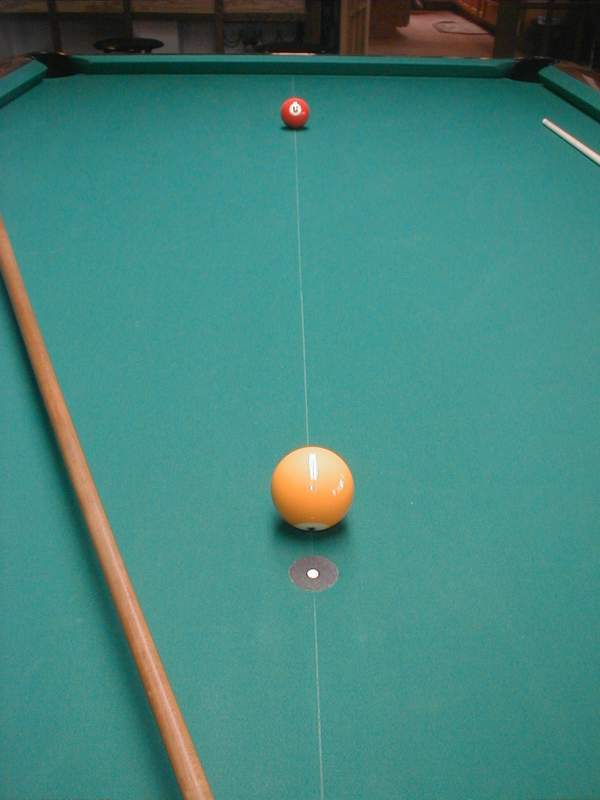
Photo 2
Ok so how should you aim? Well first lets get the bridge hand out of the way. To do this I reversed the table bridge and set it where the stick will line up perfectly with the center of the One ball. See Photo 3. I am holding the table bridge with my left hand and site with my eyes and the right hand. Here is the interesting part of this technique.
As I look down the shaft and line up from the One to the Three I get what I think is a good site picture. Notice where your nose is relative to the shaft of the cue stick and this is your site picture.
Now raise up a little bit and you can see over the Three ball to the head rail and you can see the white line. If everything is lined up then you are straight for your site picture. If not, something has to change.
Shooting the shot by stopping on the Three ball and watching the return from the rail will tell you if you site picture is the least bit off. This is a difficult shot and you have to be lined up perfectly. All I can tell you is — things will change.
Please try it. By the way, you will learn if you shoot most accurately with one eye or with two eyes.
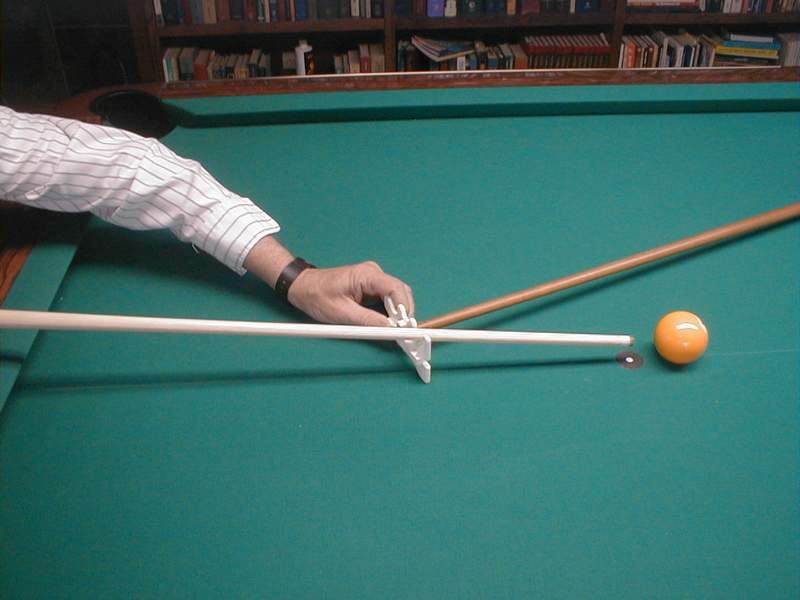
Photo 3
Dr. Dave keeps this site commercial free, with no ads. If you appreciate the free resources, please consider making a one-time or monthly donation to show your support:
